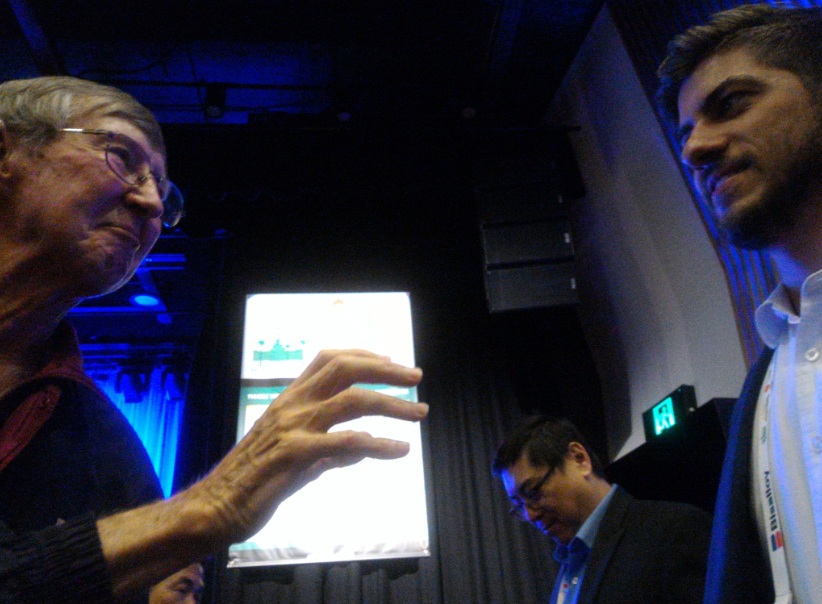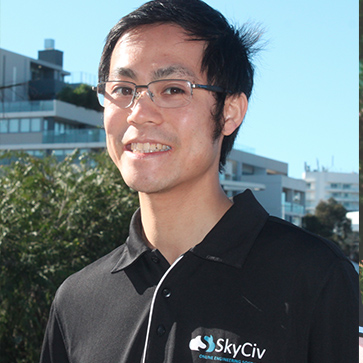 "Faccio parte della generazione di ingegneri strutturali che avevano la tua stessa età quando uscirono i computer. E stavamo facendo esattamente quello che stai facendo tu, e il software tradizionale di cui stai parlando adesso, il fatto che tu sia gentile va oltre, in realtà è nato da alcune di quelle persone che hanno fatto uno sforzo speciale, come stai facendo tu, rendere i risultati disponibili a tutti."
-George Walker, Structural Engineer
Presenting in front of an auditorium of professional structural engineers, Sam ha risposto a una serie di domande su SkyCiv. Segue una trascrizione della sessione di domande e risposte.
Domanda: C'è qualche formato di output standardizzato che potresti ottenere dal sito web? Voglio dire, la tenuta dei registri è importante, per esempio in 10 tra anni gli utenti potrebbero voler tornare indietro e rivisitare le loro analisi o i loro risultati, ti occupi di questo?
Risposta: Buona domanda, disponiamo di documenti per la conservazione dei dati. A seguito dell'analisi, puoi effettivamente produrre un report personalizzato che analizzi completamente la struttura e ti indichi anche gli input e tutte le informazioni che sono passate, con i timbri della data e la versione del software che hai utilizzato. Tiene traccia di ogni fase del processo. Ci stiamo assicurando che tu abbia una configurazione e un'analisi ben documentate in modo da poter tenere traccia di qualsiasi avanzamento. Puoi tenerlo sul tuo computer o stamparlo.
Domanda: La mia domanda riguarda la responsabilità che ti assumi fornendo il software. Hai esaminato eventuali rischi legali a cui potresti esporti da parte di persone che fanno affidamento sul tuo software se forse c'è un bug o un errore nel software di cui non sei a conoscenza nel momento in cui lo utilizzano??
Risposta: Quindi abbiamo consultato un avvocato e abbiamo seguito l'intero processo e abbiamo stipulato delle assicurazioni. Inoltre, sottoponiamo il nostro software a test rigorosi con ogni aggiornamento. Controlleremo i valori confrontandoli con letteralmente milioni di valori tra ciò che il risolutore sta producendo e i valori noti. E non lo pubblicheremo finché non sarà spuntato 100%. Ma dipende davvero dall’utente e come ingegneri non consideriamo mai il risultato come la risposta giusta. Siamo sempre scettici. Un po' di diligenza da parte degli ingegneri, ma da parte nostra mitighiamo il rischio il più possibile.
Domanda: Come convalidi i risultati che stai ottenendo dal tuo software? Il vecchio adagio è spazzatura, spazzatura fuori. Se ottieni un utente che non inserisce i dati di input corretti, sono presenti misure di sicurezza all'interno del software per evitare che ciò accada, quindi non tirano fuori la spazzatura e continuano a fare qualunque cosa ne facciano?
Risposta: Sì, sicuramente, come ho detto prima eseguiamo controlli rispetto a casi di validazione confrontando milioni di valori. Tuttavia, se un utente inserisce spazzatura, abbiamo messo in atto sistemi per catturarlo. Riceverai avvisi per cose come questa. Volevamo ridurre la possibilità che gli utenti costruissero le loro strutture in modo errato e il tempo sprecato nel cercare di scoprire cosa c'è che non va. Quindi ciò su cui ci siamo concentrati negli ultimi mesi è stato l’implementazione di sistemi di allarme migliori. Se un utente preme risolve su una trave con una sezione sottile pochi millimetri, nell'arco di un arco di tempo 10 metri, ti avviseremo e ti chiederemo “sei sicuro di avere le unità corrette??”.
Domanda: Posso solo aggiungere un commento, figliolo. Ora hai questi vari programmi in atto. Quindi dentro 5 anni, ti siederai con i piedi sollevati a rastrellarlo? Dove ti vedi? 5 anni?
Risposta: Siamo davvero concentrati sulla crescita di un’attività biologica. Molte aziende tecnologiche seguiranno lo stesso processo e la stessa sequenza temporale. Questo è avere un'idea, ottenere investitori, ingrandirsi e poi vendere. Non seguiamo necessariamente questo approccio. In realtà non abbiamo alcun investimento al momento. Stiamo avviando il processo di avvio e ci concentriamo sulla crescita di un business organico. Quindi ci piacerebbe davvero vedere SkyCiv continuare a svilupparsi in soluzioni per gli ingegneri che affrontano problemi, e continuare a creare applicazioni software che funzionino nella nostra piattaforma software esistente per risolvere tali esigenze.
Domanda: Hai menzionato l'organizzazione Fishburners che ti ha fornito supporto. Puoi semplicemente spiegare un po' meglio il supporto che danno??
Risposta: Quindi Fishburners è uno spazio di coworking dove centinaia di aziende di software e imprenditori andranno ad affittare una scrivania per un importo sovvenzionato. Non è a scopo di lucro, quindi sei circondato da persone che la pensano allo stesso modo e puoi lavorare in uno spazio creativo in cui puoi sviluppare questa tecnologia, parla con imprenditori che potrebbero essere più avanti di te e impara molto più velocemente di quanto faresti da solo in un garage. In realtà hanno appena aperto un ufficio qui a Brisbane. I Fishburners stanno davvero facendo grandi cose, quindi consiglierei a chiunque sia interessato all'innovazione o alla tecnologia di venire e farsi coinvolgere in alcuni degli eventi che organizzano e incontrare le persone che stanno guidando questa innovazione in Australia. Organizzano eventi con persone davvero in alto che scendono e condividono le loro conoscenze. Per noi questo ha davvero accelerato la nostra crescita e ci ha messo in contatto con persone davvero brave.
"Faccio parte della generazione di ingegneri strutturali che avevano la tua stessa età quando uscirono i computer. E stavamo facendo esattamente quello che stai facendo tu, e il software tradizionale di cui stai parlando adesso, il fatto che tu sia gentile va oltre, in realtà è nato da alcune di quelle persone che hanno fatto uno sforzo speciale, come stai facendo tu, rendere i risultati disponibili a tutti."
-George Walker, Structural Engineer
Presenting in front of an auditorium of professional structural engineers, Sam ha risposto a una serie di domande su SkyCiv. Segue una trascrizione della sessione di domande e risposte.
Domanda: C'è qualche formato di output standardizzato che potresti ottenere dal sito web? Voglio dire, la tenuta dei registri è importante, per esempio in 10 tra anni gli utenti potrebbero voler tornare indietro e rivisitare le loro analisi o i loro risultati, ti occupi di questo?
Risposta: Buona domanda, disponiamo di documenti per la conservazione dei dati. A seguito dell'analisi, puoi effettivamente produrre un report personalizzato che analizzi completamente la struttura e ti indichi anche gli input e tutte le informazioni che sono passate, con i timbri della data e la versione del software che hai utilizzato. Tiene traccia di ogni fase del processo. Ci stiamo assicurando che tu abbia una configurazione e un'analisi ben documentate in modo da poter tenere traccia di qualsiasi avanzamento. Puoi tenerlo sul tuo computer o stamparlo.
Domanda: La mia domanda riguarda la responsabilità che ti assumi fornendo il software. Hai esaminato eventuali rischi legali a cui potresti esporti da parte di persone che fanno affidamento sul tuo software se forse c'è un bug o un errore nel software di cui non sei a conoscenza nel momento in cui lo utilizzano??
Risposta: Quindi abbiamo consultato un avvocato e abbiamo seguito l'intero processo e abbiamo stipulato delle assicurazioni. Inoltre, sottoponiamo il nostro software a test rigorosi con ogni aggiornamento. Controlleremo i valori confrontandoli con letteralmente milioni di valori tra ciò che il risolutore sta producendo e i valori noti. E non lo pubblicheremo finché non sarà spuntato 100%. Ma dipende davvero dall’utente e come ingegneri non consideriamo mai il risultato come la risposta giusta. Siamo sempre scettici. Un po' di diligenza da parte degli ingegneri, ma da parte nostra mitighiamo il rischio il più possibile.
Domanda: Come convalidi i risultati che stai ottenendo dal tuo software? Il vecchio adagio è spazzatura, spazzatura fuori. Se ottieni un utente che non inserisce i dati di input corretti, sono presenti misure di sicurezza all'interno del software per evitare che ciò accada, quindi non tirano fuori la spazzatura e continuano a fare qualunque cosa ne facciano?
Risposta: Sì, sicuramente, come ho detto prima eseguiamo controlli rispetto a casi di validazione confrontando milioni di valori. Tuttavia, se un utente inserisce spazzatura, abbiamo messo in atto sistemi per catturarlo. Riceverai avvisi per cose come questa. Volevamo ridurre la possibilità che gli utenti costruissero le loro strutture in modo errato e il tempo sprecato nel cercare di scoprire cosa c'è che non va. Quindi ciò su cui ci siamo concentrati negli ultimi mesi è stato l’implementazione di sistemi di allarme migliori. Se un utente preme risolve su una trave con una sezione sottile pochi millimetri, nell'arco di un arco di tempo 10 metri, ti avviseremo e ti chiederemo “sei sicuro di avere le unità corrette??”.
Domanda: Posso solo aggiungere un commento, figliolo. Ora hai questi vari programmi in atto. Quindi dentro 5 anni, ti siederai con i piedi sollevati a rastrellarlo? Dove ti vedi? 5 anni?
Risposta: Siamo davvero concentrati sulla crescita di un’attività biologica. Molte aziende tecnologiche seguiranno lo stesso processo e la stessa sequenza temporale. Questo è avere un'idea, ottenere investitori, ingrandirsi e poi vendere. Non seguiamo necessariamente questo approccio. In realtà non abbiamo alcun investimento al momento. Stiamo avviando il processo di avvio e ci concentriamo sulla crescita di un business organico. Quindi ci piacerebbe davvero vedere SkyCiv continuare a svilupparsi in soluzioni per gli ingegneri che affrontano problemi, e continuare a creare applicazioni software che funzionino nella nostra piattaforma software esistente per risolvere tali esigenze.
Domanda: Hai menzionato l'organizzazione Fishburners che ti ha fornito supporto. Puoi semplicemente spiegare un po' meglio il supporto che danno??
Risposta: Quindi Fishburners è uno spazio di coworking dove centinaia di aziende di software e imprenditori andranno ad affittare una scrivania per un importo sovvenzionato. Non è a scopo di lucro, quindi sei circondato da persone che la pensano allo stesso modo e puoi lavorare in uno spazio creativo in cui puoi sviluppare questa tecnologia, parla con imprenditori che potrebbero essere più avanti di te e impara molto più velocemente di quanto faresti da solo in un garage. In realtà hanno appena aperto un ufficio qui a Brisbane. I Fishburners stanno davvero facendo grandi cose, quindi consiglierei a chiunque sia interessato all'innovazione o alla tecnologia di venire e farsi coinvolgere in alcuni degli eventi che organizzano e incontrare le persone che stanno guidando questa innovazione in Australia. Organizzano eventi con persone davvero in alto che scendono e condividono le loro conoscenze. Per noi questo ha davvero accelerato la nostra crescita e ci ha messo in contatto con persone davvero brave.
William Kuang
Ingegnere e sviluppatore di software
BEng Mechanical (Hons1)
LinkedIn
Ingegnere e sviluppatore di software
BEng Mechanical (Hons1)



